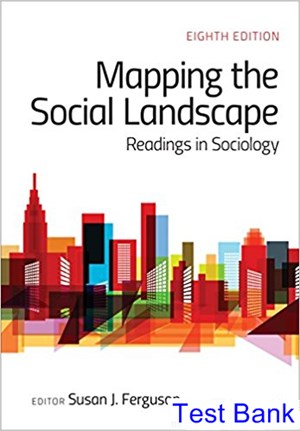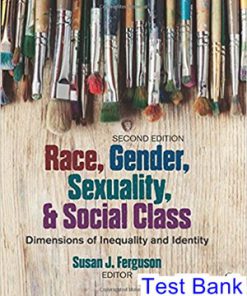Now with SAGE Publishing, Mapping the Social Landscape: Readings in Sociology is one of the most established and widely-used anthologies for Introductory Sociology. Susan J. Ferguson selects, edits, and introduces 58 readings representing a plurality of voices and views within sociology. The selections include classic statements from great thinkers like C. Wright Mills, Karl Marx, Howard Becker, and Max Weber, as well as the works of contemporary scholars who address current social issues. Many of the readings integrate questions of diversity, helping students see the interrelationships among race-ethnicity, social class, and gender, and understand how these relationships have shaped the experiences of all people in society.
New selections focus on
o how Superstorm Sandy damaged social as well as physical structures
o gender panics and bathrooms
o extreme poverty in the United States
o transgender challenges to our understanding of gender
o a Muslim American punk rock subculture that is challenging Islamophobia
o lessons from the Affordable Care Act
o revolutionary movements for social change
Table contents:
Part I: The Sociological Perspective
Chapter 1: The Promise – C. Wright Mills
Chapter 2: Teenage Wasteland: Suburbia’s Dead-End Kids – Donna Gaines
Chapter 3: An Intersection of Biography and History: My Intellectual Journey – Mary Romero
Theory
Chapter 4: Theoretical Perspectives in Sociology – Chris Hunter and Kent McClelland
Chapter 5: The Manifesto of the Communist Party – Karl Marx and Friedrich Engels
Chapter 6: On Being Sane in Insane Places – David L. Rosenhan
Social Research
Chapter 7: Finding Out How the Social World Works – Michael Schwalbe
Chapter 8: Interpersonal Dynamics in a Simulated Prison – Craig Haney, W. Curtis Banks, and Philip G. Zimbardo
Chapter 9: Working at Bazooms: The Intersection of Power, Gender, and Sexuality – Meika Loe
Part II. Culture
Chapter 10: Culture: A Sociological View – Howard S. Becker
Chapter 11: Raising Global Children Across the Pacific – Pei-Chia Lan
Chapter 12: Lovely Hula Hands: Corporate Tourism and the Prostitution of Hawaiian Culture – Haunani-Kay Trask
Part III. Socialization
Chapter 13: “No Way My Boys Are Going to Be Like That!”: Parents’ Responses to Children’s Gender Nonconformity – Emily W. Kane
Chapter 14: Using Racial and Ethnic Concepts: The Critical Case of Very Young Children – Debra Van Ausdale and Joe R. Feagin
Chapter 15: Making It By Faking It: Working-Class Students in an Elite Academic Environment – Robert Granfield
Chapter 16: Anybody′s Son Will Do – Gwynne Dyer
Part IV. Groups and Social Structure
Chapter 17: The Birth of the Intravidual – Dalton Conley
Chapter 18: Peer Power: Clique Dynamics among School Children – Patricia A. Adler and Peter Adler
Chapter 19: Shopping as Symbolic Interaction: Race, Class, and Gender in the Toy Store – Christine L. Williams
Part V. Deviance, Crime, and Social Control
Chapter 20: From Nowhere: Space, Race, and Time in How Young Minority Men Understand Encounters with Gangs – Randol Contreras
Chapter 21: Fraternities and Collegiate Rape Culture: Why Are Some Fraternities More Dangerous Places for Women? – A. Ayres Boswell and Joan Z. Spade
Chapter 22: Descent into Madness: The New Mexico State Prison Riot – Mark Colvin
Part VI. Social Inequality
Social Class
Chapter 23: Some Principles of Stratification – Kingsley Davis and Wilbert E. Moore
Chapter 24: Who Rules America?: The Corporate Community and the Upper Class – G. William Domhoff
Chapter 25: Race, Homeownership, and Wealth – Thomas M. Shapiro
Chapter 26: Understanding the Dynamics of $2-a-Day Poverty in the United States – H. Luke Shaefer, Kathyrn Edin, and Elizabeth Talbert
Gender
Chapter 27: Gender as Structure – Barbara Risman
Chapter 28: Doing Gender, Determining Gender: Transgender People, Gender Panics, and the Maintenance of the Sex/Gender/Sexuality System – Laurel Westbrook and Kristen Schilt
Chapter 29: “Dude, You’re a Fag”: Adolescent Masculinity and the Fag Discourse – C. J. Pascoe
Chapter 30: Because She Looks Like a Child – Kevin Bales
Race and Ethnicity
Chapter 31: What Is Racial Domination? – Matthew Desmond and Mustafa Emirbayer
Chapter 32: At a Slaughterhouse, Some Things Never Die – Charlie LeDuff
Chapter 33: Out of Sorts: Adoption and (Un)Desirable Children – Katherin M. Flower Kim
Chapter 34: Yearning for Lightness: Transnational Circuits in the Marketing and Consumption of Skin Lighteners – Evelyn Nakano Glenn
Part VII. Social Institutions
Power and Politics
Chapter 35: The Power Elite – C. Wright Mills
Chapter 36: Bully Nation: How the American Establishment Creates a Bullying Society – Charles Derber and Yale R. Magrass
Chapter 37: The New Global Elite – Chrystia Freeland
Mass Media
Chapter 38: Must-See TV: South Asian Characterizations in American Popular Media – Bhoomi K. Thakore
Chapter 39: “It’s Dude Time!”: A Quarter Century of Excluding Women’s Sports in Televised News and Highlight Shows – Cheryl Cooky, Michael A. Messner, and Michela Musto
Chapter 40: Dangerous Pipelines, Dangerous People: Colonial Ecological Violence and Media Framing of Threat in the Dakota Access Pipeline Conflict – J. M. Bacon
The Economy and Work
Chapter 41: Over the Counter: McDonald′s – Robin Leidner
Chapter 42: Racializing the Glass Escalator: Reconsidering Men’s Experiences with Women’s Work – Adia Harvey Wingfield
Chapter 43: The Time Bind: When Work Becomes Home and Home Becomes Work – Arlie Russell Hochschild
Religion
Chapter 44: The Protestant Ethic and the Spirit of Capitalism – Max Weber
Chapter 45: Religion and Society: Of Gods and Demons – Steven P. Dandaneau
Chapter 46: Racialization of Muslims – Saher Selod and David G. Embrick
Health and Medicine
Chapter 47: Racism and Health: Pathways and Scientific Evidence – David R. Williams and Selina A. Mohammed
Chapter 48: Sand Castles and Snake Pits – Lillian B. Rubin
Chapter 49: A Slow, Toxic Decline: Dialysis Patients, Technological Failure, and the Unfulfilled Promise of Health in America – Keith Wailoo
Education
Chapter 50: Civilize Them with a Stick – Mary Crow Dog and Richard Erdoes
Chapter 51: A School in the Garden – Mitchell L. Stevens
Chapter 52: Bad Boys: Public Schools in the Making of Black Masculinity – Ann Arnett Ferguson
The Family
Chapter 53: The Deinstitutionalization of American Marriage – Andrew J. Cherlin
Chapter 54: Promises I Can Keep: Why Poor Women Put Motherhood Before Marriage – Kathryn Edin and Maria Kefalas
Chapter 55: Unequal Childhoods: Class, Race, and Family Life – Annette Lareau
Part VIII. Social Change
Chapter 56: Revolutions and Regime Change – Jeff Goodwin and René Rojas
Chapter 57: Superstorm Sandy: Restoring Security at the Shore – Diane C. Bates
Chapter 58: A New Political Generation: Millennials and the Post-2008 Wave of Protest – Ruth Milkman
People also search:
mapping the social landscape readings in sociology 8th edition pdf
mapping the social landscape 8th edition pdf
|
mapping the social landscape 8th edition pdf free
mapping the social landscape readings in sociology 9th edition













